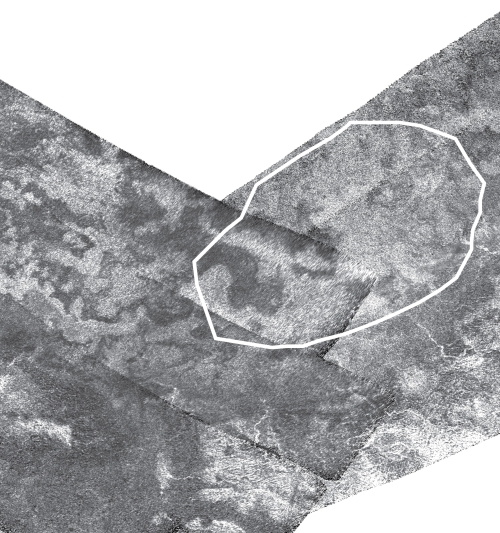![]() Remember when we could only guess what lay beneath Titan’s thick atmosphere? Thanks to Cassini and the Huygens lander, things are very different now. We have had a surface both strange and strangely familiar revealed to us, with mountains, rivers and lakes shaped by the flow of liquid ethane, and dunes of hydrocarbon sand. Furthermore, multiple flybys by Cassini in the past 5 years has allowed long-term monitoring of the surface, with consecutive observations of the same region enabling us to chart the evolution of Titan’s surface over time. Some recent publications in Geophysical Reseach Letters have spotted some rather interesting changes.
Remember when we could only guess what lay beneath Titan’s thick atmosphere? Thanks to Cassini and the Huygens lander, things are very different now. We have had a surface both strange and strangely familiar revealed to us, with mountains, rivers and lakes shaped by the flow of liquid ethane, and dunes of hydrocarbon sand. Furthermore, multiple flybys by Cassini in the past 5 years has allowed long-term monitoring of the surface, with consecutive observations of the same region enabling us to chart the evolution of Titan’s surface over time. Some recent publications in Geophysical Reseach Letters have spotted some rather interesting changes.
Firstly, Turtle et al. report the appearance of several dozen dark patches in the southern polar region between observations in July 2004 (circled region, left, below) and June 2005 (right).
These dark areas have similar characteristics to the extensive lakes that have been found around the Titanian north pole, and Turtle et al. interpret them as such; they also note that lots of clouds were observed around the south pole in the time between the two images (they’re also visible as bright patches in the images themselves), which lends support to the hypothesis that a recent hydrocarbon rainstorm created these lakes. The seasons on Titan last several Earth years, but the presently lake-rich northern hemisphere is currently moving towards summer, whilst the lake-poor southern hemisphere is heading for winter; is it possible that this distribution will reverse itself? We’ll have to wait and see.
Meanwhile, two related papers by Nelson et al. and Wall et al. give the details on a surface change that may be related to geological activity. Nelson et al. report that between October 2005 and January 2006, a region near the highland region of Hotei Arcus became much darker at infrared wavelengths. This change was still apparent after another pass in March 2006, suggesting that it was due to a permanent alteration of the surface rather than a transient effect, like low-lying clouds or fog. Wall et al. present some follow-up observations by Cassini’s radar imager in early 2008, which reveals some interesting features in this region (the white border shows the area that got darker in infrared)

This area seems to consist of a dark plain topped by brighter areas with lobate, or curved, boundaries with complex overlapping relationships, particularly in the upper right. They also appear to cover channels running down from the highlands in the bottom right of the image. Based on the morphology and their apparent youth, Wall et al. propose that the bright units are recently erupted cryogenic lava flows. Many people think that for the methane and other hydrocarbons in Titan’s atmosphere to persist over long timescales, they must be replenished by eruptions of volatiles from Titan’s mushy interior. The resolution is a bit low to say for certain, but it’s possible that we’re looking at the aftermath of a recent eruption.
Cassini is still going strong – it’s current extended mission is planned to continue until autumn 2010 – so hopefully we’ll get more insight into the meterological and geological forces that are continuing to shape Titan.
E. P. Turtle, J. E. Perry, A. S. McEwen, A. D. DelGenio, J. Barbara, R. A. West, D. D. Dawson, C. C. Porco (2009). Cassini imaging of Titan’s high-latitude lakes, clouds, and south-polar surface changes Geophysical Research Letters, 36 (2) DOI: 10.1029/2008GL036186
Robert M. Nelson, Lucas W. Kamp, Rosaly M. C. Lopes, Dennis L. Matson, Randolph L. Kirk, Bruce W. Hapke, Stephen D. Wall, Mark D. Boryta, Frank E. Leader, William D. Smythe, Karl L. Mitchell, Kevin H. Baines, Ralf Jaumann, Christophe Sotin, Roger N. Clark, Dale P. Cruikshank, Pierre Drossart, Jonathan I. Lunine, Michel Combes, Giancarlo Bellucci, Jean-Pierre Bibring, Fabrizio Capaccioni, Pricilla Cerroni, Angioletta Coradini, Vittorio Formisano, Gianrico Filacchione, Yves Langevin, Thomas B. McCord, Vito Mennella, Phillip D. Nicholson, Bruno Sicardy, Patrick G. J. Irwin, John C. Pearl (2009). Photometric changes on Saturn’s Titan: Evidence for active cryovolcanism Geophysical Research Letters, 36 (4) DOI: 10.1029/2008GL036206
S. D. Wall, R. M. Lopes, E. R. Stofan, C. A. Wood, J. L. Radebaugh, S. M. H??rst, B. W. Stiles, R. M. Nelson, L. W. Kamp, M. A. Janssen, R. D. Lorenz, J. I. Lunine, T. G. Farr, G. Mitri, P. Paillou, F. Paganelli, K. L. Mitchell (2009). Cassini RADAR images at Hotei Arcus and western Xanadu, Titan: Evidence for geologically recent cryovolcanic activity Geophysical Research Letters, 36 (4) DOI: 10.1029/2008GL036415




Comments (1)